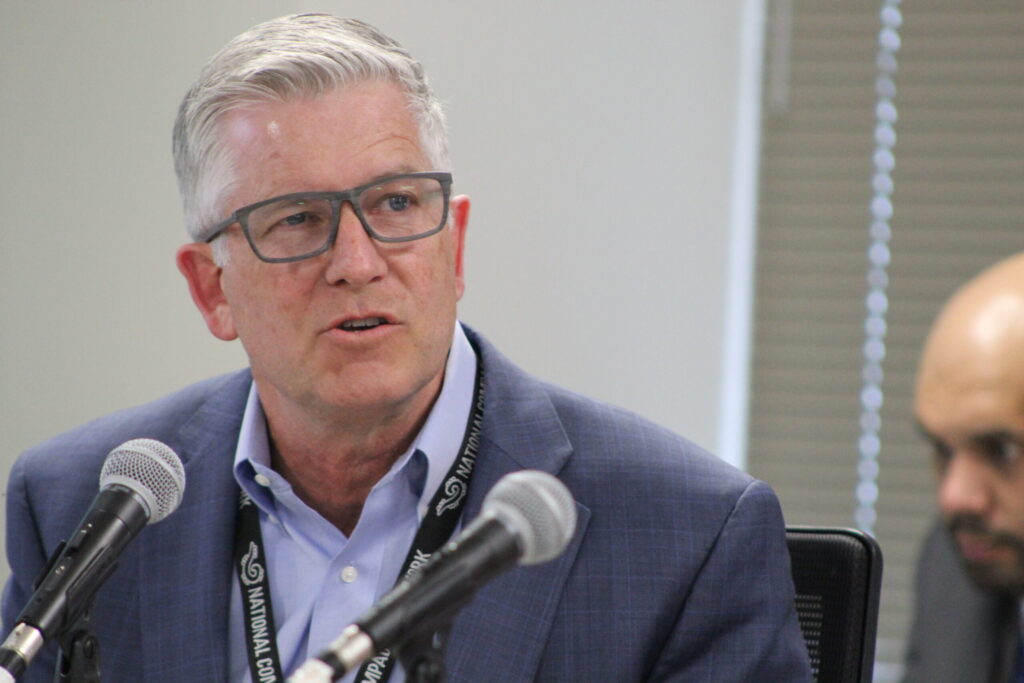Pondering our past, present and future municipal piping pickle | HUDSON

Miller Hudson
As if we didn’t have enough to worry about what with continuing political gridlock in Washington, impending climate disasters, stubbornly high interest rates and a stock market riding on animal spirits, there are ample worries regarding our personal health.
Immune system diseases have been on the rise for decades and rumors of a looming bird flu pandemic are whispered in dairy barns across the country, including here in Colorado. Tens of millions of chickens and turkeys have been slaughtered at industrial brooding sheds in the effort to contain its spread. More insidious, however, may be a suspicion both airborne and water pollutants are starting to damage our organ systems following decades of constant exposure.
More than 350,000 chemical compounds have been created in commercial labs, a few of which have indisputably improved our lives, while the consequences of the remainder are far more dubious. Only several hundred have ever been reviewed for their toxicity or assigned “maximum contaminant levels” (MCLs) set by the Environmental Protection Agency and state health agencies. The bulk of the rest are derived from fossil fuels, primarily petroleum, natural gas and their cousins, many of which have been identified as established carcinogens. This includes the so-called “forever” polyfluoroalkyl (PFAS) substances once prevalent in hikers’ water bottles, baby food packaging, firefighting foams and other consumer packaging. The U.S. Department of Defense budget now provides billions of dollars annually to clean up PFAS intrusions into municipal water systems. The Air Force faces a major calamity in Colorado Springs as does the Navy in Hawaii.
Stay up to speed: Sign up for daily opinion in your inbox Monday-Friday
It took nearly three decades for the medical profession to recognize permissible worker radiation exposures produced a far different result when repeated over time. In 1950 my father was one of 12 engineers assigned by Phillips Petroleum, contractor for management of the Atomic Energy Commission’s reactor test site in Arco, Idaho, to design and qualify naval reactor propulsion systems. When he died in 1983, at 59, he had been pre-deceased by 10 of his companions. It wasn’t all cancer, but a range of degenerative medical consequences precipitated by prolonged minimal exposures. A single X-ray presents negligible risk, while daily X-rays lead to biological damage — the reason your dental tech leaves the room when shooting your teeth. My Dad acknowledged the employment-related source of his illness and explained, “We were all veterans (World War II) who had risked our lives in the face of enemy fire, so it was hard to worry about a threat we couldn’t see, hear or feel.”
Increasingly, researchers are beginning to suspect the chemical soup that now surrounds us in modern life may be generating similar cumulative exposure damage. It’s hardly reassuring nano- and micro-plastic beads have been detected both in male sperm and spinal fluid. Understanding the links between neurodevelopmental disorders and chemical toxicity is in its infancy. We’ve known for half-a-century multiple sclerosis (MS) rates in Colorado are the highest in the nation without a single, plausible explanation for this. I’ve concluded any substance with four or more syllables — think polyethylene, di-tert-butyl-phenol, chlorodibromomethane, hexachlorobutadiene, isopropylbenzene — are substances you probably don’t want appearing in your tap water.
The Biden infrastructure act earmarked $15 billion to fund a replacement of lead service pipes in water systems throughout the nation. Lead is a malleable, cheap piping material used to deliver water since the Roman empire, only outlawed here in 1986. Latin histories tell us it was well known plumbers became a dull lot, although I was impressed to see their pipes snaking through tenements when I visited Pompeii. They had the right idea. It wasn’t so long ago Michigan determined it was delivering water to an entire city, Flint, heavily contaminated with lead pollution, that recognition partially triggered by the low academic achievement scores for their schools. Many older Colorado water systems have applied for grants to complete lead line replacements by 2030.
Environmentalists and others are raising concern using PVC (polyvinyl chloride) piping to replace lead service lines risks what may prove nearly as toxic a practice. While working for the phone company, we often installed PVC wiring conduit in new buildings to isolate our cables. When stored in our garage overnight, I recall being overwhelmed first thing in the morning by the pungent, chemical odor from the “off-gassing” of the fresh piping. This chemical, airborne brew is related to the “new car” smell we are all familiar with until the spanking-new interior plastics have fully ventilated. We know PVC piping, when used to transport water, sheds many of those four syllable compounds I mentioned earlier. These are complex molecules and recognized carcinogens in other applications.
The reason why the freight accident in East Palestine, Ohio was so disastrous several years ago is because the train was transporting liquid and pellet forms of vinyl chloride, which then caught fire, releasing hydrogen chloride, phosgene (a known poison), and likely dioxins as well. PVC is seductively attractive to local governments since it is marginally cheaper and easier to work with than metals like copper or cast iron. In the overall cost of lead replacement, piping only represents about 5% of total costs. When a water main burst in front of my 1903 Denver Square near City Park a few years ago, I was surprised to discover my service line was a century-old lead pipe. It was replaced with shiny, copper tubing by Denver Water.
There are no nastier legislative fights than “turf” wars. PVC peddlers, and their advocates at the Vinyl Institute, will trumpet claims their product lasts longer, is easier to maintain and cheaper to purchase. I would suggest erring on the side of caution. Otherwise, there is ample evidence we will be returning in 20 years, this time for $50 billion dollars, to replace PVC and CPVC with proven metal piping.
In Jordan Chariton’s devastating account of Michigan’s water crisis, “We, the Poisoned,” he concludes with this advice, “I firmly believe the nightmare the people of Flint have been living through can happen to any of us… to be clear: the Flint water crisis and cover-up is not some horrible tragedy from the past. The crisis is ongoing. Despite the cherry-picked spin from government and the media, the city’s water is still contaminated, and its people are still waiting for the rescue choppers.” These are words the Colorado legislature, county commissioners and municipal council members should take to heart before any victims arrive at their doors.
Miller Hudson is a public affairs consultant and a former Colorado legislator.










